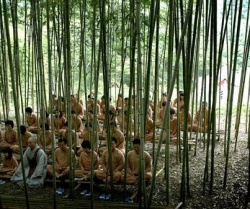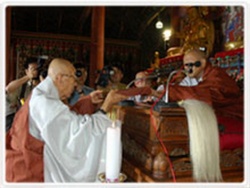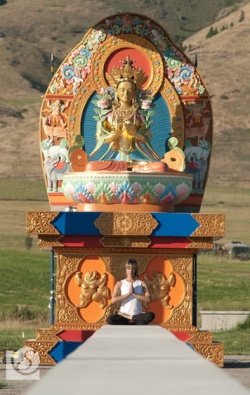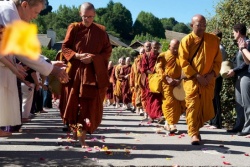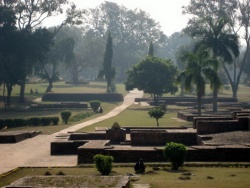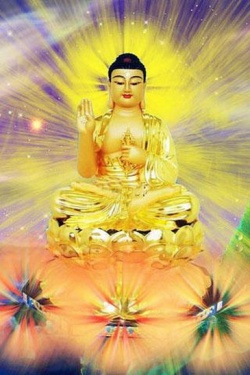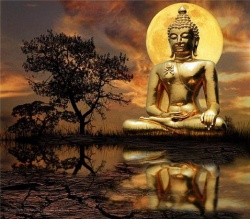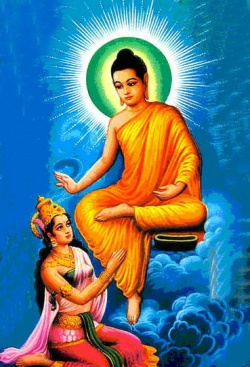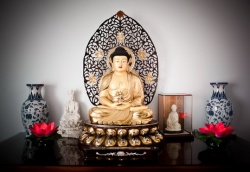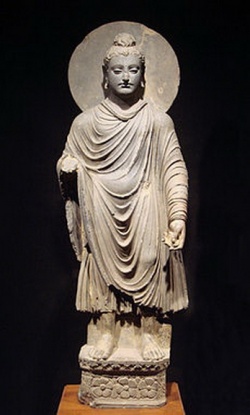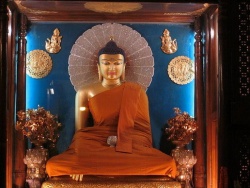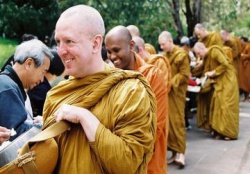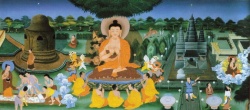Difference between revisions of "The Sobhana Cittas in our life"
m (Text replace - "great" to "great") |
m (Text replacement - "change" to "change") |
||
| Line 97: | Line 97: | ||
[[self]], the cycle of [[merit]] wrought in the past. | [[self]], the cycle of [[merit]] wrought in the past. | ||
| − | As regards a favorable place of residence, living in a [[Buddhist]] country can be a helpful [[condition]] for [[kusala]] [[cittas]]. Then one has the opportunity to visit [[temples]] and to listen to the preaching of [[Dhamma]]. The [[Dhamma]] can | + | As regards a favorable place of residence, living in a [[Buddhist]] country can be a helpful [[condition]] for [[kusala]] [[cittas]]. Then one has the opportunity to visit [[temples]] and to listen to the preaching of [[Dhamma]]. The [[Dhamma]] can change our [[life]] and it is the [[condition]] for the performing of [[wholesome]] deeds, for [[dana]], [[sila]] and [[bhavana]]. |
As regards 'association with the good', this means association with the right friend in [[Dhamma]]. If one, even though living in a [[Buddhist]] country, does not meet the right friend in [[Dhamma]] who can help in the search for the [[truth]], one lacks the [[condition]] which is most helpful for the cultivation of [[wisdom]] and the eradication of [[defilements]]. | As regards 'association with the good', this means association with the right friend in [[Dhamma]]. If one, even though living in a [[Buddhist]] country, does not meet the right friend in [[Dhamma]] who can help in the search for the [[truth]], one lacks the [[condition]] which is most helpful for the cultivation of [[wisdom]] and the eradication of [[defilements]]. | ||
Revision as of 11:17, 30 September 2013
There are many different types of citta and they can be classified by way of four jatis:
kusala cittas (wholesome cittas)
akusala cittas (unwholesome cittas)
vipakacittas (cittas which are result)
kiriyacittas (cittas which are neither cause nor result)
However, they can also be classified by way of sobhana, asobhana.
1. sobhana cittas, cittas accompanied by sobhana (beautiful) cetasikas.
2. asobhana cittas, cittas unaccompanied by sobhana cetasikas.
Both akusala cittas and ahetuka cittas are asobhana cittas, they are not accompanied by sobhana cetasikas. As we have seen, there are twelve types of akusala citta. They are:
8 types of lobha-mula-citta (cittas rooted in attachment)
2 types of dosa-mula-citta (cittas rooted in aversion)
2 types of moha-mula-citta (cittas rooted in ignorance)
As regards ahetuka cittas, they are cittas which are not accompanied by any hetus (roots). When the citta is ahetuka there are no sobhana cetasikas arising with the citta and thus ahetuka cittas are asobhana. As we have seen, there are eighteen types of ahetuka citta. Summarizing them, they are :
10 dvi-panca-vinnanas, which are ahetuka vipakacittas
(the five pairs which are seeing, hearing, etc. )
2 sampaticchana-cittas, which are ahetuka
vipakacittas (one kusala vipaka and one akusala vipaka).
3 santirana-cittas, which are ahetuka vipakacittas
(one akusala vipaka, one kusala vipaka,
accompanied by upekkha, and one kusala vipaka,
accompanied by somanassa).
1 panca-dvaravajjana-citta (five-sense-door-
adverting-consciousness) which is ahetuka kiriyacitta.
1 mano-dvaravajjana-citta (mind-door-adverting-consciousness)
which is ahetuka kiriyacitta.
1 hasituppada-citta, an ahetuka kiriyacitta which can
produce the smile of the arahat.
Thus, there are thirty asobhana cittas : twelve akusala cittas and eighteen ahetuka cittas.
There are also sobhana cittas arising in our life, cittas which are accompanied by sobhana cetasikas. Three among the sobhana cetasikas are hetu, root. They are : alobha, adosa and amoha or panna. Sobhana cittas are always accompanied by alobha and adosa and they may or may not be accompanied by panna. Thus, sobhana cittas are sahetuka, accompanied by hetus. When we perform dana
(generosity), observe sila (morality) or apply ourselves to bhavana (which comprises samatha, vipassana and the study or teaching of Dhamma), there are kusala cittas, accompanied by sobhana cetasikas. Thus kusala cittas are among the sobhana cittas.
The kusala cittas which perform dana, observe sila or apply themselves to bhavana are cittas belonging to the lowest plane of consciousness, the sensuous plane ; they are kamavacara cittas. Kamavacara cittas are the cittas we have in daily life, when, for example, we are seeing, thinking or wishing for something. Sometimes kamavacara cittas arise with sobhana hetus (beautiful roots), sometimes with akusala hetus, and sometimes without any hetus. Dana, sila or bhavana is performed by kamavacara kusala cittas: these kinds of kusala kamma can be performed in daily life, where there are impressions through the six doors. Kamavacara kusala cittas are called 'maha-kusala cittas' ('maha' means 'many' or 'great').
For those who attain jhana (absorption, developed in samatha or tranquil meditation) there is at that moment no seeing, hearing or any other sense-impression ; then the citta is not kamavacara citta, but it is of a higher plane of consciousness. The jhanacittas can be rupavacara cittas (rupa-jhanacittas) or arupavacara cittas (arupa-jhanacittas). However, while one is developing samatha the cittas are maha-kusala cittas before one attains jhana.
When the citta directly experiences nibbana, the citta is lokuttara bhumi (lokuttara plane of consciousness). However, lokuttara kusala cittas (magga-cittas) are preceded by maha-kusala cittas in the process of cittas during which enlightenment is attained.
We would like to have kusala cittas more often. We may think that the circumstances of our life or other people prevent us from kusala. However, if we know the conditions for the cultivation of kusala, there will be more kusala cittas in our life. Through the study of the Dhamma we will learn how to cultivate kusala. If we have not studied Dhamma we may think that we are performing kusala, while we have, on the contrary, akusala cittas. For example, we may think that when giving something away, there are only kusala cittas. However, lobha-mula-cittas may also arise. We may give something to friends and expect them to be kind to us in return. This is not kusala, but lobha. When we study Dhamma we learn that the pure way of giving is giving without expecting anything in return. We should find out why we are giving. Do we, deep in our hearts, wish for something in return? Or do we want to have less defilements?
People have different accumulations and because of these accumulations kusala cittas or akusala cittas arise. For example, when people visit a temple and see others presenting gifts to the monks, they may, because of their different accumulations, react in different ways. Some people may appreciate someone else's good deeds; others may not be interested at all. If one would only know the value of kusala and realize that appreciating the good deeds of others is a way of dana (generosity), one would use more opportunities to cultivate wholesomeness.
If the Buddha had not attained enlightenment and taught Dhamma we would not have any means of knowing ourselves thoroughly ; we would not have a precise knowledge of our kusala cittas and akusala cittas and of the conditions through which they arise. The Buddha taught people how to cultivate wholesomeness and to eradicate defilements and thus, living according to the precepts and performing other kinds of wholesomeness is the way to pay respect to him. We read in the 'Maha-Parinibbana-sutta' (Dialogues of the Buddha II, No. 16, Ch.V, 137, 138) that before the Buddha passed away, the twin Sala trees, which were full of flowers although it was not the season, dropped their flowers all over his body, heavenly Mandarava-flowers and sandalwood-powder descended on his body and heavenly music sounded out of reverence for him. The Buddha said to Ananda:
'Now it is not thus, Ananda, that the Tathagata is
rightly honoured, reverenced, venerated, held sacred
or revered. But the monk or the sister, the devout
man or the devout woman, who continually fulfills all
the greater and the lesser duties, who is correct in
life, walking according to the precepts- - it is he who
rightly honours, reverences, venerates, holds sacred,
and reveres the Tathagata with the worthiest homage.
Therefore, Ananda, be constant in the fulfillment of
the greater and of the lesser duties, and be correct
in life, walking according to the precepts ; and thus,
Ananda, should it be taught.'
We all have in our daily life opportunities for dana and sila. As regards bhavana, this comprises samatha, vipassana, studying Dhamma or explaining it to others. Not only the monks, but also laypeople can study and teach Dhamma. We read in the 'MahaParinibbana-sutta' (Ch. III, l12, l13) that the Buddha told Ananda that Mara, the Evil One, had said to the Buddha after his enlightenment that it was now the time for him to pass away. The Buddha said:
And when he had thus spoken, Ananda, I addressed
Mara, the Evil One, and said:- -'I shall not pass away,
O Evil One! until not only the monks and sisters of
the Order, but also the lay-disciples of either sex shall
have become true hearers, wise and well trained, ready
and learned, carrying the teachings in their memory,
masters of the lesser corolaries that follow from the
larger doctrine, correct in life, walking according to
the precepts-- until they, having thus themselves learned
the doctrine, shall be able to tell others of it, preach
it, make it known, establish it, open it, minutely explain
it and make it clear-- until they, when others start vain
doctrine easy to be refuted by the truth, shall be able
in refuting it to spread the wonderworking truth abroad!
I shall not die until this pure religion of mine shall
have become successful, prosperous, widespread, and
popular in all its full extent-- until, in a word, it shall
have been well proclaimed among men!'
The fact that we are able to perform wholesome deeds in our lives is due to conditions, it is not due to a self. We read in the 'Tenfold Series' (Dialogues of the Buddha III, No. 34, Ch. IV, 276) about factors which are helpful :
Four... that help much:-- four 'wheels', to wit, the
orbit of a favorable place of residence, the orbit of
association with the good, perfect adjustment of one's
self, the cycle of merit wrought in the past.
As regards a favorable place of residence, living in a Buddhist country can be a helpful condition for kusala cittas. Then one has the opportunity to visit temples and to listen to the preaching of Dhamma. The Dhamma can change our life and it is the condition for the performing of wholesome deeds, for dana, sila and bhavana.
As regards 'association with the good', this means association with the right friend in Dhamma. If one, even though living in a Buddhist country, does not meet the right friend in Dhamma who can help in the search for the truth, one lacks the condition which is most helpful for the cultivation of wisdom and the eradication of defilements.
'Perfect adjustment of one's self' is 'adjusting oneself' with kusala as the goal. There are many degrees of kusala. If one develops the wisdom of the Eightfold Path by being mindful of nama and rupa, there will be less clinging to the concept of self. If there is mindfulness of nama and rupa while performing wholesome deeds, one will come to realize that no self, no person performs these deeds. Thus kusala kamma will become purer and eventually defilements will be eradicated.
The accumulation of kusala in the past is the fourth factor which is helpful. If we haven't accumulated kusala in the past how can we do good deeds in the present? The kusala kammas which were accumulated in the past are the condition for us to go to the right place and meet the right people. It is kamma which causes one to be born in a Buddhist Country or to live in a Buddhist country. The kusala accumulated in the past conditions our study and practice of the Dhamma at the present time. If we consider the factors in our life which are the conditions for kusala we will better understand that it is not self which performs good deeds.
In the Abhidhamma we learn that there are eight types of maha-kusala cittas, kusala cittas of the sensuous plane of consciousness. Why isn't there only one type? The reason is that each type has its own conditions through which it arises.
If we know about these different types and if we can be aware of them when their characteristics present themselves, it will help us not to take them for self. Four types of maha-kusala cittas arise with somanassa (pleasant feeling) and four types arise with upekkha (indifferent feeling). We would like to have kusala cittas with somanassa, because we cling to somanassa. However, one cannot force somanassa to arise. Sometimes we perform dana with somanassa, sometimes with upekkha. It depends on conditions whether somanassa or whether upekkha arises with the maha-kusala citta. Four types are accompanied by wisdom : four types are not accompanied by wisdom. We may, for example, help others without panna or with panna. When we realize that helping is kusala, or when we are aware of the nama or rupa appearing at that moment, there is panna arising with the maha-kusala citta. Four types are asankharika (unprompted, spontaneous, not induced by someone else or by one's own consideration) and four types are sasankharika (prompted, by someone else or by self-inducement) The eight types of maha-kusala cittas are the following: .
1. Accompanied by pleasant feeling, with wisdom, unprompted
(Somanassa-sahagatam, nana-sampayuttum, asankharikam ekam)
2. Accompanied by pleasant feeling, with wisdom, prompted
(Somanassa-sahagatam, nana-sampayuttam, sasankharikam ekam)
3. Accompanied by pleasant feeling, without wisdom, unprompted
(Somanassa-sahagatam, nana-vippayuttam, asankharikam ekam)
4. Accompanied by pleasant feeling, without wisdom, prompted
(Somanassa-sahagatam, nana-vippayuttam, sasankharikam ekam)
5. Accompanied by indifferent feeling, with wisdom, unprompted
(Upekkha-sahagatam, nana-sampayuttam, asankharikam ekam)
6. Accompanied by indifferent feeling, with wisdom, prompted
(Upekkha-sahagatam, nana-sampayuttam, sasankharikam ekam)
7. Accompanied by indifferent feeling, without wisdom, unprompted
(Upekkha-sahagatam, nana-vippayuttam, asankharikam ekam)
8. Accompanied by indifferent feeling, without wisdom, prompted
(Upekkha-sahagatam, nana-vippayuttam, sasankhaikam ekam)
Maha-kusala cittas are not the only kind of kamavacara sobhana cittas (beautiful cittas which are of the sensuous plane of consciousness). Maha-kusala cittas are cittas which are cause; they can motivate kusala kamma through body, speech
or mind which is capable of bringing results. There are also maha-vipakacittas, which are results of kusala kamma performed with maha-kusala cittas. Maha-vipakacittas are sobhana (beautiful) cittas as well, arising with sobhana cetasikas. People's deeds are not the same and thus the results cannot be the same. People are born with different patisandhi-cittas (rebirth-consciousness). Patisandhi-cittas are vipakacittas ; they are the result of kamma.
As we have seen before (Ch, 11), human beings can be born with a patisandhi-citta which is ahetuka kusala vipaka (and in this case they are handicapped from the first moment of life), or with a patisandhi-citta which is sahetuka kusala vipaka, accompanied by sobhana hetus. In the case of human beings, and of beings born in other sensuous planes of existence, the patisandhi-citta which is sahetuka vipakacitta is maha-vipakacitta, the result of kamavacara kusala kamma (kamma performed by kusala cittas of the sensuous plane of consciousness). Apart from maha-vipakacitta there are other types of sahetuka vipakacitta which are not the result of kamavacara kusala kamma but of jhanacitta. These types will be dealt with later on.
As regards maha-vipakacittas, there are eight types. They can be accompanied by somanassa or by upekkha, they can be with panna or without panna, they can be asankharika (unprompted) or sasankharika (prompted). They are classified in the same way as the eight types of maha-kusala cittas mentioned above.
The bhavanga-citta (life-continuum) and the cuti-citta (dying-consciousness) are the same type of citta as the first citta in one's life, the patisandhi-citta. If the patisandhi-citta is maha-vipakacitta, the bhavanga-citta and the cuti-citta of that life are the same type of maha-vipakacitta. Thus the functions of patisandhi, bhavanga and cuti can be performed by maha-vipakacitta. Moreover, the function of tadarammana (registering) can also be performed by maha-vipakacitta.
When we see a beautiful sight or experience pleasant objects through the other sense-doors, the citta is vipakacitta, the result of kusala kamma ; however, that kind of vipakacitta is ahetuka vipaka (arising without hetu), not maha-vipaka. The functions of seeing, hearing, smelling, tasting and receiving impressions through the body-sense, of sampaticchana and of santirana cannot be performed by maha-vipakacittas ; these functions are performed by ahetuka vipakacittas. Tadarammana-citta (registering-consciousness), however, which is a vipakacitta arising after the javana-cittas, can either be ahetuka vipakacitta or maha-vipakacitta.
There are still other kinds of kamavacara sobhana cittas : the maha-kiriyacittas. The arahat has maha-kiriyacittas instead of maha-kusala cittas. When we experience a pleasant object lobha may arise and when we experience an unpleasant object dosa may arise. The arahat has equanimity towards pleasant objects or unpleasant objects ; he has no defilements. Since he cannot accumulate any more akusala kamma or kusala kamma, he has maha-kiriyacittas (inoperative cittas). For the arahat, there are, instead of maha-kusala cittas, maha-kiriyacittas performing the function of javana after the votthapana-citta (determining-consciousness) and the mano-dvaravajjana-citta (mind-door-adverting-consciousness). One may wonder whether the arahat can have maha-kiriyacittas which are nana-vippayutta (not accompanied by wisdom). Arahats can have maha-kiriyacittas which are nana-vippayutta, because panna does not necessarily accompany the maha-kiriyacittas when they are not preaching or discussing Dhamma.
The arahat has kiriyacittas which are sobhana cittas and also kiriyacittas which are asobhana cittas. The panca-dvaravajjana-citta (five-sense-door-adverting-consciousness), the mano-dvaravajjana-citta and the hasituppada-citta (smile-producing-consciousness of the arahat) are asobhana kiriyacittas. These types of citta are not accompanied by sobhana cetasikas, they are ahetuka.
There are eight types of maha-kiriyacittas in all. They are accompanied by somanassa or by upekkha, they are accompanied by panna or not accompanied by panna, they are asankharika or sasankharika. They are classified in the same way as the eight types of maha-kusala cittas.
Altogether there are fifty-four cittas which are kama-bhumi (Bhumi is plane, in this case, plane of citta, not plane of existence.), or kamavacara cittas, cittas of the sensuous plane of consciousness. They are:
12 akusala cittas
18 ahetuka cittas }30 sobhana cittas
8 maha-kusala cittas
8 maha-vipakacittas }24 sobhana cittas
8 maha-kiriyacittas
There are also sobhana cittas which are not kama-sobhana cittas, namely :
the sobhana cittas which are rupa-bhumi
(rupavacara cittas, for those who attain rupa-jhana)
the sobhana cittas which are arupa-bhumi
(arupavacara cittas, for those who attain arupa-jhana)
the sobhana cittas which are lokuttara-bhumi, for
those who attain enlightenment
Only kamavacara cittas (cittas of the kama-bhumi or sensuous plane of consciousness) can be asobhana cittas. Cittas which are rupa-bhumi, arupa-bhumi and lokuttara-bhumi can only be sobhana cittas.
Those who do not attain jhana or attain enlightenment cannot have the cittas of the other bhumis, but they can verify the truth of the Buddha's teachings as regards the kama-bhumi. We can find out for ourselves whether it is helpful to perform dana, observe sila and cultivate bhavana. We can find out whether the cultivation of these ways of kusala helps us to have less akusala cittas. Sometimes it is the right moment for dana, sometimes for sila or for bhavana. Vipassana, however, one can cultivate while performing dana, observing sila, cultivating samatha, or while one is studying or teaching Dhamma, and also at those moments when there is no opportunity for dana, sila or the other ways of kusala. Even if mindfulness of nama and rupa has not yet been accumulated much, one can find out whether it is a condition for having less akusala cittas and less attachment to the concept of self. In being mindful we can verify the truth of the Buddha's teachings.
We read in the 'Gradual Sayings' (Book of the Sevens, Ch. VIII, par. 9, The message):
'Now the venerable Upali came to the Exalted One,
saluted and sat down at one side. So seated, he said:
'Well were it for me, lord, if the Exalted One were
to expound Dhamma briefly to me, so that, having
heard it, I might abide resolute, alone, secluded, earnest
and zealous.'
'The doctrines, Upali, of which you may know; 'These
doctrines lead one not to complete weariness (of the
world), nor to dispassion, nor to ending, nor to calm, nor
to knowledge, nor to the awakening, nor to the cool' --
regard them definitely as not Dhamma, not the discipline,
not the word of the Teacher. But the doctrines of which
you may know : 'These doctrines lead one to complete
weariness, dispassion, ending, calm, knowledge, the
awakening, the cool'-- regard them unreservedly as
Dhamma, the discipline, the word of the Teacher.'
